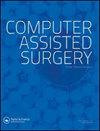骨-踝短突配准在微创人工耳蜗植入中的应用
IF 1.9
4区 医学
Q3 SURGERY
引用次数: 3
摘要
摘要目的:本文提出并探讨骨-踝短突配准在微创人工耳蜗植入中的应用,并评价该策略在图像引导耳科手术中的应用价值。材料和方法:用浅靶和深靶标记10个颞骨标本,测量配准分辨率。采用了两种配准方法。方法A(新型配准方法)为骨-踝短突配准,方法B(传统配准方法)为乳突面附着4枚钛螺钉配准。在浅基准目标和深基准目标上测量目标配准误差(TRE)。A方法配准后,对另外8个颞骨标本进行经皮耳蜗钻孔,观察与靶点和入点的偏差。结果:A方法在标本浅层基准点处观察到的误差小于1 mm,在深层基准点处观察到的误差近似等于1 mm。与方法b相比,结果没有显著差异。在使用方法A的8个研究案例中,成功进行了钻井作业。与靶点和入点的偏差分别为0.84±0.30 mm和0.66±0.51 mm。结论:本研究结果表明,新配准方法与传统配准方法相比具有相同的精度,且具有较小的侵入性。因此,该方法具有侵入性小、准确性高的特点,可能是一种可行的图像引导耳科手术配准方法。本文章由计算机程序翻译,如有差异,请以英文原文为准。
Application of bonebed-malleus short process registration in minimally invasive cochlear implantation
Abstract Purpose: This article proposed and investigated the application of bonebed-malleus short process registration in minimally invasive cochlear implantation, and assessed the value of the proposed strategy for image-guided otologic surgery. Materials and methods: Ten temporal bone specimens were marked with both shallow and deep targets in order to measure registration resolutions. Two registration methods were applied. Method A (a new registration method) consisted of bonebed-malleus short process registration, while method B (traditional registration method) comprised registration using four titanium screws attached at the mastoid surface. The target registration errors (TRE) were measured at both the shallow and deep fiducial targets. After registration achieved by method A, percutaneous cochlear drilling was conducted on the other eight temporal bone specimens in order to observe the deviation from the target point and entry point. Results: Using method A, the error observed at the shallow fiducial markers of specimens was less than 1 mm, while the error observed at the deep fiducial markers was approximately equal to 1 mm. No significant difference was observed when results were compared with the application of method B. In eight studied cases using method A, drilling operations were successfully conducted. The deviations from the target point and the entry point were 0.84 ± 0.30 and 0.66 ± 0.51 mm, respectively. Conclusions: Results of the present study indicated that the new registration method demonstrated identical accuracy when compared to traditional registration method, achieved less invasiveness. Thus, the proposed method might be a feasible registration method for image-guided otologic surgery due to its mild invasiveness and high accuracy.
求助全文
通过发布文献求助,成功后即可免费获取论文全文。
去求助
来源期刊

Computer Assisted Surgery
Medicine-Surgery
CiteScore
2.30
自引率
0.00%
发文量
13
审稿时长
10 weeks
期刊介绍:
omputer Assisted Surgery aims to improve patient care by advancing the utilization of computers during treatment; to evaluate the benefits and risks associated with the integration of advanced digital technologies into surgical practice; to disseminate clinical and basic research relevant to stereotactic surgery, minimal access surgery, endoscopy, and surgical robotics; to encourage interdisciplinary collaboration between engineers and physicians in developing new concepts and applications; to educate clinicians about the principles and techniques of computer assisted surgery and therapeutics; and to serve the international scientific community as a medium for the transfer of new information relating to theory, research, and practice in biomedical imaging and the surgical specialties.
The scope of Computer Assisted Surgery encompasses all fields within surgery, as well as biomedical imaging and instrumentation, and digital technology employed as an adjunct to imaging in diagnosis, therapeutics, and surgery. Topics featured include frameless as well as conventional stereotactic procedures, surgery guided by intraoperative ultrasound or magnetic resonance imaging, image guided focused irradiation, robotic surgery, and any therapeutic interventions performed with the use of digital imaging technology.
 求助内容:
求助内容: 应助结果提醒方式:
应助结果提醒方式:


